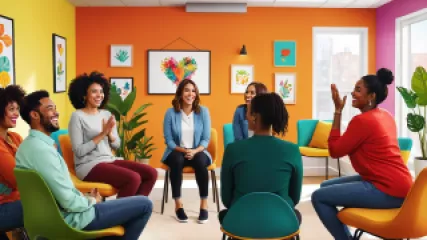The Impact of Humor Therapy on Positive Mindset: Research Insights
The study of humor therapy has gained considerable traction in recent years as researchers explore its potential benefits for mental health and overall well-being. Humor, often considered an essential aspect of human life, not only provides entertainment but also serves as a therapeutic tool to foster a positive mindset. This article delves into the impact of humor therapy on fostering a positive mindset, drawing from extensive research insights.
The Concept of Humor Therapy
Humor therapy, often referred to as laughter therapy, involves the use of humor to promote emotional well-being and improve physical health. It is based on the premise that laughter can trigger positive physiological and psychological responses. The concept isn't new; it dates back to ancient civilizations where humor was used as a healing mechanism.
The Science Behind Humor Therapy
Research has shown that humor triggers the release of endorphins, the body's natural feel-good chemicals. These chemicals promote an overall sense of well-being and can temporarily relieve pain. Moreover, humor reduces stress hormones, decreases anxiety, and enhances immune function, making it a powerful tool for maintaining a healthy body and mind.
Evidence Supporting Humor Therapy
A growing body of research supports the efficacy of humor therapy in improving mental health. Several studies have demonstrated that humor therapy can reduce symptoms of depression, anxiety, and stress, thereby promoting a positive mindset.
Impact on Depression
One significant area of research focuses on humor therapy for depression. Studies have found that engaging in therapeutic humor online sessions or virtual humor coaching sessions can significantly reduce depressive symptoms. The laughter induced during these sessions helps break the cycle of negative thoughts and feelings, providing relief and fostering a more positive outlook.
"Laughter is an instant vacation." Milton Berle
Resilience Building through Laughter
Laughter therapy for resilience building is another crucial aspect explored by researchers. Resilience refers to the ability to bounce back from adversity. Humor therapy enhances resilience by helping individuals view challenging situations from a different perspective, making them seem less threatening. This shift in perception empowers individuals to cope better with stress and setbacks.
Case Study: Resilience in Healthcare Workers
A notable study examined the impact of humor therapy on healthcare workers experiencing burnout. The results indicated that those who participated in regular humor therapy sessions reported higher resilience levels and a more positive mindset compared to their counterparts who did not engage in such activities.
Mechanisms of Humor Therapy
Understanding the mechanisms behind humor therapy is crucial for grasping its impact on a positive mindset. Researchers have identified several key mechanisms through which humor therapy exerts its effects.
Physiological Mechanisms
When we laugh, our body undergoes several physiological changes. These include increased oxygen intake, enhanced circulation, and the release of endorphins. These changes not only create a sense of relaxation but also boost the body's natural healing processes.
Psychological Mechanisms
Psychologically, humor therapy helps in reframing negative thoughts. By introducing humor into stressful situations, individuals can distance themselves from their problems, gaining a new perspective. This cognitive shift is vital for developing a positive mindset.
Example: Cognitive Reframing
Consider a person dealing with a stressful work deadline. Humor therapy might involve watching a funny video or engaging in a light-hearted conversation, which helps the individual view the situation as less daunting, reducing anxiety and enhancing problem-solving abilities.
Applications of Humor Therapy
Humor therapy is versatile and can be applied in various settings, including clinical environments, workplaces, and everyday life. Its adaptability makes it an effective tool for a wide range of populations.
Clinical Settings
In clinical settings, humor therapy is used as a complementary treatment for patients with chronic illnesses, mental health disorders, and those undergoing rehabilitation. Therapists often incorporate humor into their sessions to make the therapeutic process more engaging and less intimidating.
Example: Humor in Oncology
Oncology patients undergoing chemotherapy often experience high levels of stress and anxiety. Integrating humor therapy into their treatment plan can alleviate some of this emotional burden, improving their overall quality of life.
Workplace Wellness Programs
Many organizations are now recognizing the benefits of humor therapy for employee well-being. Incorporating laughter yoga sessions, comedy workshops, and humor-based team-building activities can foster a positive work environment, reduce stress, and enhance productivity.
Example: Corporate Laughter Yoga
A tech company implemented weekly laughter yoga sessions for its employees. Over six months, they observed a significant reduction in workplace stress and an increase in job satisfaction and team cohesion.
Challenges and Limitations
While humor therapy offers numerous benefits, it is essential to acknowledge its challenges and limitations. Not every individual responds to humor in the same way, and cultural differences can influence perceptions of what is funny.
Individual Differences
Personal preferences play a significant role in the effectiveness of humor therapy. What one person finds hilarious, another might find offensive or irrelevant. Tailoring humor therapy to individual preferences is crucial for its success.
Cultural Considerations
Cultural background influences humor perception. Jokes or comedic styles that are popular in one culture might not resonate with another. Therapists must be culturally sensitive and adapt their approach to suit diverse populations.
Example: Cultural Sensitivity in Humor Therapy
In a multicultural group therapy session, therapists may use universally relatable humor, such as physical comedy, to ensure inclusivity and avoid cultural misunderstandings.
Future Directions in Humor Therapy Research
As interest in humor therapy continues to grow, future research is likely to explore new dimensions and applications. Emerging trends suggest a focus on personalized humor therapy and the integration of technology to enhance accessibility.
Personalized Humor Therapy
Advancements in artificial intelligence and machine learning could pave the way for personalized humor therapy programs. These programs would analyze an individual's humor preferences and tailor content to maximize therapeutic benefits.
Technology Integration
Virtual humor coaching sessions and therapeutic humor online sessions are becoming increasingly popular. These remote options provide greater accessibility, allowing individuals to benefit from humor therapy regardless of geographical location.
Example: Virtual Humor Coaching
A pilot study on virtual humor coaching sessions for college students found that participants experienced reduced stress levels and improved mood, demonstrating the potential of technology-assisted humor therapy.
Conclusion
Humor therapy holds significant promise as a tool for fostering a positive mindset. Through its physiological and psychological mechanisms, humor therapy can alleviate symptoms of depression, enhance resilience, and promote overall well-being. While challenges exist, ongoing research and technological advancements offer exciting opportunities for expanding its reach and efficacy. As we continue to explore the power of laughter, humor therapy may well become an integral part of holistic health care and everyday life.






